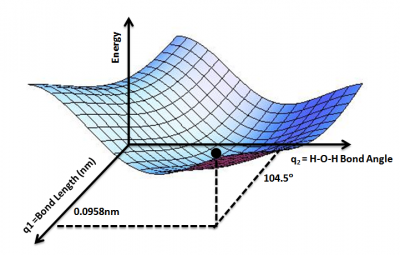Difference between revisions of "Convergence Problems"
| Line 7: | Line 7: | ||
== Geometry Optimization Problems == | == Geometry Optimization Problems == | ||
| − | Geometry optimization aims to find the geometry where the forces are zero (or close enough). The structure with zero forces is the most stable, or ground structure. The problem is that there are usually many variables to change and optimize. Every atom has three coordinates that can be changed (x, y, z coordinates). So finding the ground structure is not always straight-forward. | + | Geometry optimization aims to find the geometry where the forces are zero (or close enough). The structure with zero forces is the most stable, or ground structure. The problem is that there are usually many variables to change and optimize. Every atom has three coordinates that can be changed (x, y, z coordinates). So finding the ground structure is not always straight-forward. See below for a relatively simple example (water). The ground structure for water occurs at a specific bond angle and bond distance. Larger molecules have many more variables to optimize. Numerical algorithms are used to keep trying geometries until the ground structure is found, and sometimes they don't always work. |
| − | [[File:Potential_Energy_Surface_for_Water.png]] | + | [[File:Potential_Energy_Surface_for_Water.png|400px]] |
| + | |||
| + | === What should I do about geometry problems? === | ||
| + | |||
| + | # Always monitor the energies and forces of your calculation. Are they going up over time? Going down? Oscillating? This can tell you | ||
Revision as of 11:28, 18 February 2020
My calculation didn't work!
This is a common complaint when performing molecular modeling simulations. You start the calculation, and come back many hours later to find it didn't finish correctly or didn't converge. This usually means either (1) the calculation crashed (hopefully with error messages that you can google) or (2) the calculation is taking a very long time, perhaps despite restarting the calculation multiple times.
Below we discuss several issues related to converging simulations. Recall that there are two convergence loops that DFT calculations will run through: wavefunction optimization (i.e. scf convergence) and geometry optimization. The program first determines the wavefunction for a given geometry, which gives the forces and energies of that geometry. Then the program will update the geometry to a new structure based on the calculated forces. It will re-calculate the wavefunction, then geometry, and repeat until the system is finally converged and the geometry is optimized.
Geometry Optimization Problems
Geometry optimization aims to find the geometry where the forces are zero (or close enough). The structure with zero forces is the most stable, or ground structure. The problem is that there are usually many variables to change and optimize. Every atom has three coordinates that can be changed (x, y, z coordinates). So finding the ground structure is not always straight-forward. See below for a relatively simple example (water). The ground structure for water occurs at a specific bond angle and bond distance. Larger molecules have many more variables to optimize. Numerical algorithms are used to keep trying geometries until the ground structure is found, and sometimes they don't always work.
What should I do about geometry problems?
- Always monitor the energies and forces of your calculation. Are they going up over time? Going down? Oscillating? This can tell you
